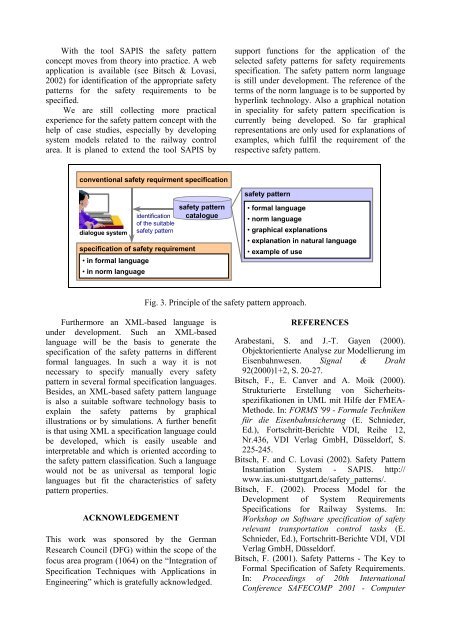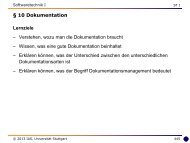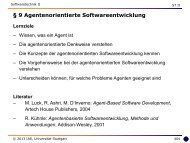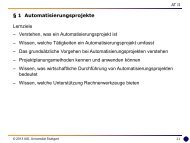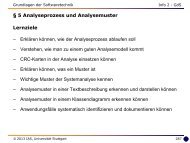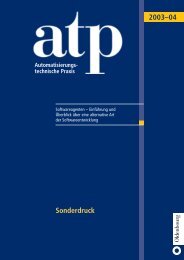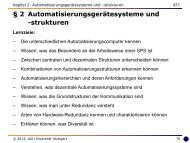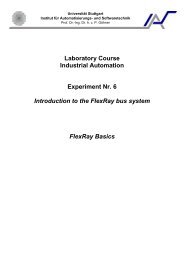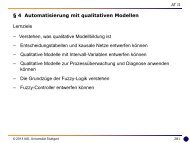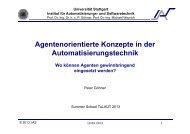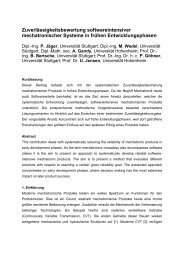a way for applicable formal specification of safety requirements by ...
a way for applicable formal specification of safety requirements by ...
a way for applicable formal specification of safety requirements by ...
You also want an ePaper? Increase the reach of your titles
YUMPU automatically turns print PDFs into web optimized ePapers that Google loves.
With the tool SAPIS the <strong>safety</strong> pattern<br />
concept moves from theory into practice. A web<br />
application is available (see Bitsch & Lovasi,<br />
2002) <strong>for</strong> identification <strong>of</strong> the appropriate <strong>safety</strong><br />
patterns <strong>for</strong> the <strong>safety</strong> <strong>requirements</strong> to be<br />
specified.<br />
We are still collecting more practical<br />
experience <strong>for</strong> the <strong>safety</strong> pattern concept with the<br />
help <strong>of</strong> case studies, especially <strong>by</strong> developing<br />
system models related to the rail<strong>way</strong> control<br />
area. It is planed to extend the tool SAPIS <strong>by</strong><br />
support functions <strong>for</strong> the application <strong>of</strong> the<br />
selected <strong>safety</strong> patterns <strong>for</strong> <strong>safety</strong> <strong>requirements</strong><br />
<strong>specification</strong>. The <strong>safety</strong> pattern norm language<br />
is still under development. The reference <strong>of</strong> the<br />
terms <strong>of</strong> the norm language is to be supported <strong>by</strong><br />
hyperlink technology. Also a graphical notation<br />
in speciality <strong>for</strong> <strong>safety</strong> pattern <strong>specification</strong> is<br />
currently being developed. So far graphical<br />
representations are only used <strong>for</strong> explanations <strong>of</strong><br />
examples, which fulfil the requirement <strong>of</strong> the<br />
respective <strong>safety</strong> pattern.<br />
conventional <strong>safety</strong> requirment <strong>specification</strong><br />
<strong>safety</strong> pattern<br />
dialogue system<br />
<strong>safety</strong> pattern<br />
identification catalogue<br />
<strong>of</strong> the suitable<br />
<strong>safety</strong> pattern<br />
<strong>specification</strong> <strong>of</strong> <strong>safety</strong> requirement<br />
• in <strong>for</strong>mal language<br />
• in norm language<br />
• <strong>for</strong>mal language<br />
• norm language<br />
• graphical explanations<br />
• explanation in natural language<br />
• example <strong>of</strong> use<br />
Fig. 3. Principle <strong>of</strong> the <strong>safety</strong> pattern approach.<br />
Furthermore an XML-based language is<br />
under development. Such an XML-based<br />
language will be the basis to generate the<br />
<strong>specification</strong> <strong>of</strong> the <strong>safety</strong> patterns in different<br />
<strong>for</strong>mal languages. In such a <strong>way</strong> it is not<br />
necessary to specify manually every <strong>safety</strong><br />
pattern in several <strong>for</strong>mal <strong>specification</strong> languages.<br />
Besides, an XML-based <strong>safety</strong> pattern language<br />
is also a suitable s<strong>of</strong>tware technology basis to<br />
explain the <strong>safety</strong> patterns <strong>by</strong> graphical<br />
illustrations or <strong>by</strong> simulations. A further benefit<br />
is that using XML a <strong>specification</strong> language could<br />
be developed, which is easily useable and<br />
interpretable and which is oriented according to<br />
the <strong>safety</strong> pattern classification. Such a language<br />
would not be as universal as temporal logic<br />
languages but fit the characteristics <strong>of</strong> <strong>safety</strong><br />
pattern properties.<br />
ACKNOWLEDGEMENT<br />
This work was sponsored <strong>by</strong> the German<br />
Research Council (DFG) within the scope <strong>of</strong> the<br />
focus area program (1064) on the “Integration <strong>of</strong><br />
Specification Techniques with Applications in<br />
Engineering” which is gratefully acknowledged.<br />
REFERENCES<br />
Arabestani, S. and J.-T. Gayen (2000).<br />
Objektorientierte Analyse zur Modellierung im<br />
Eisenbahnwesen. Signal & Draht<br />
92(2000)1+2, S. 20-27.<br />
Bitsch, F., E. Canver and A. Moik (2000).<br />
Strukturierte Erstellung von Sicherheitsspezifikationen<br />
in UML mit Hilfe der FMEA-<br />
Methode. In: FORMS '99 - Formale Techniken<br />
für die Eisenbahnsicherung (E. Schnieder,<br />
Ed.), Fortschritt-Berichte VDI, Reihe 12,<br />
Nr.436, VDI Verlag GmbH, Düsseldorf, S.<br />
225-245.<br />
Bitsch, F. and C. Lovasi (2002). Safety Pattern<br />
Instantiation System - SAPIS. http://<br />
www.ias.uni-stuttgart.de/<strong>safety</strong>_patterns/.<br />
Bitsch, F. (2002). Process Model <strong>for</strong> the<br />
Development <strong>of</strong> System Requirements<br />
Specifications <strong>for</strong> Rail<strong>way</strong> Systems. In:<br />
Workshop on S<strong>of</strong>tware <strong>specification</strong> <strong>of</strong> <strong>safety</strong><br />
relevant transportation control tasks (E.<br />
Schnieder, Ed.), Fortschritt-Berichte VDI, VDI<br />
Verlag GmbH, Düsseldorf.<br />
Bitsch, F. (2001). Safety Patterns - The Key to<br />
Formal Specification <strong>of</strong> Safety Requirements.<br />
In: Proceedings <strong>of</strong> 20th International<br />
Conference SAFECOMP 2001 - Computer


